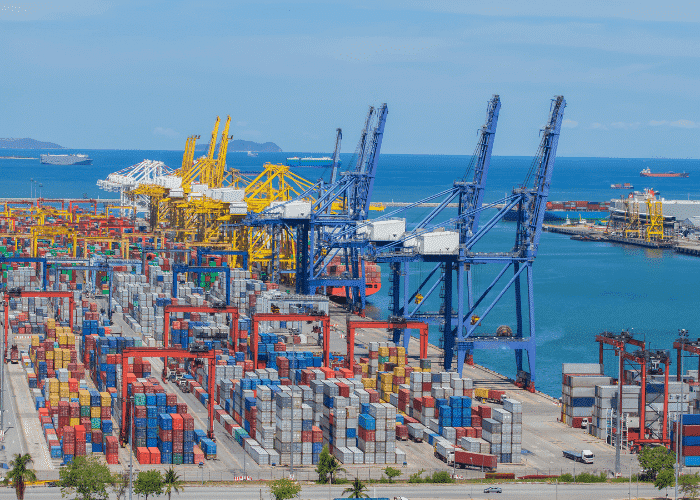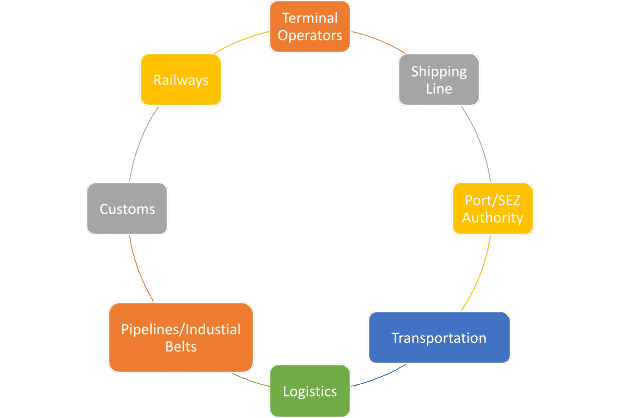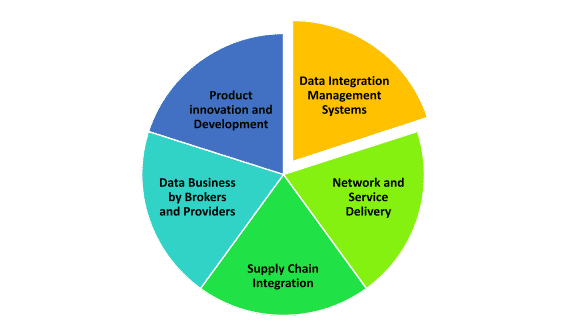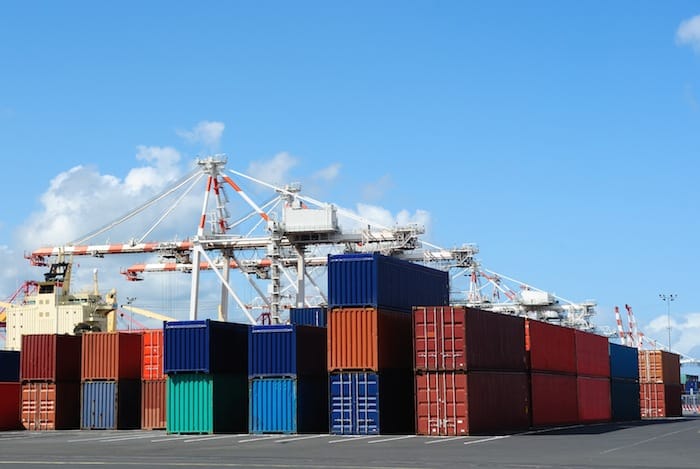What Are Smart Port Technologies?
This implies greater manpower, more overheads, more space and acquisitions, quality infrastructure, lesser downtime and most importantly, greater efficacy.
While most can be materialized with higher revenues and strengthening business, the pressure on these places to meet increasing expectations needs to be eased, at the same time not compromising on the efficiency and quality standards.
This is where automation and data come into play.
Smart Ports are essential infrastructure that uses automation, integration of services, digitization and data-driven techniques for functioning as ports dedicated for management of cargo, mainly using technologies such as the Internet of Things (IoT), Big Data, Block-chain technologies, augmented reality and other smart and data-science based interfaces. The name smart itself implies the capabilities of the port and the integrated workflow.
With the ever-increasing maritime traffic, greater frequency of cargo loading/unloading, more number of vessels operating in a given trade route and movement of multifarious cargo, the practices in Smart Ports are essential for increased manpower, management, controls and paraphernalia.

Fundamental Benchmarks For Ports And Terminals
Before highlighting the capabilities of smart ports let us delve into the yardsticks that measure the performance and sustainability of a port/terminal, harbour or any large cargo-handling facility:
Infrastructure
It goes without saying that this is the most pivotal determinant of any such facility. The size of the port/terminal, the volume of cargo it caters to, the number of vessels it can handle for loading/offloading and also the features that enable it to sustain for seamless handling of cargo and logistics in low downtime also endowing on the expansion of its business with increasing demand-supply.
Not only the equipment but also the capabilities of all those equipment for handling large volumes is equally crucial. A port with a cranage of 500 Tons always has an upper hand over another with 100 or 200 Tons.
Similarly, a container terminal with measures for handling larger TEU containers is a manifold advantage over another with lower limits. These factors depend on a plethora of heads, cost being the prime of them. The overall competence of a facility and its infrastructure has a simple proportionality with the investment adduced for it.
However, this is merely not enough. The efficient utilization of the investment in terms of resources, lesser downtime, quality standards and most importantly, safety are sought after for a successfully operating port.
Traffic
Traffic in ports is broad of two kinds- external and internal or intermodal. A competitive port facility has to meet both of these for unhindered efficiency. External is, of course, the ocean traffic related to the vessels venturing in and out for cargo loading and unloading. The intermodal is the traffic related to trucks, trailers, trains, carriages and other means of localized transportation of goods to and from the facility. The delay of one affects another. At the same time, the dilatory effects of anyone take a toll on the functionality of the overall infrastructure as well.
Quality
Quality assurance, like any other business, is one of the cornerstones. Quality encompasses a wide range of facets from proper and safe handling of cargo, maintaining standard workability of components and equipment, cleanliness and hygiene, systematic arrangement and stowage of cargo, etc. Quality Management standards pertaining to ISO 9000 divisions need to be scrupulously maintained.
Safety
It possibly the most fundamental aspect of these kinds of infrastructure which involves a high index of risks and hazards. Regular safety checks for machinery and equipment, training personnel, providing adequate and certified protective measures and promulgating awareness about safety measures and their implementations are indispensable.
Health is another crucial factor under this, the recent pandemic making major ports foster more exigent measures for the present and future. ISO 45000 family which takes into consideration occupational health and safety is being expedited at insuperable levels by almost all major ports and terminals globally.
Location and Expansion
Last but not the least, this is applicable for any forms of infrastructure, irrespective of all the above. Optimizing the congenial location for business and expansion along with other factors such as land availability, connectivity, demographics, economy, climate, topography etc. has been a quest for ports for a very long time.
Once this benchmark is fixated, adhering to everything else including the above is necessary. Locations can be multifarious based on availability and requirement. Bays, estuaries, delta and riverine ports are some of the common kinds.
Security
This may not be ostensibly germane in the functioning and net outcomes but is intrinsically related to every minutia of these facilities.
Security can range over everything from security of freight to safety of personnel and equipment and of course, systems, cybersecurity and data (ISO 27000). Will delve more into this aspect in the later parts of our discussion on Smart Port and Technologies.
Customs and Collection and all financial/monetary bottlenecks
Environmental Friendliness and Lesser Emissions
Importance Of Smart Ports
Today, smart ports have everything that ports till even a few years back could simply dream of.
Listing all the above benchmarks to cater for multitudes of new demands in terms of:
- Structural and geographical changes in markets and distributions, the complexity of operations: With changing mechanics of business and demand-supply cycle along with other supporting factors, the ports need to come up with long-term solutions to cater for sustainability and expansion. A classic example would be the rising importance of Western European ports like Antwerp, Amsterdam etc. as compared to Eastern ones.
- Globalization and market liberalization
- Dynamics of International Trade and increasing complexity of logistics chain.
- Market Competition
- Security Issues
- Environmental Sustainability
Ports, till the 1960s were simple sites for loading/unloading. It developed in the later years to be industrial ports that served the dual purpose of production and consequent circulation of the goods overseas.
This demanded more prodigious sites for both the industry as well as their supplies’ ‘distribution basin’ in the forms of ports and harbours.
Now in this third-generation era, ports are not the points of connection between the land and sea but much more.
These can be considered as nodal points between cities, supply chains, personnel, industrial hubs and even other ports in partnership.
These are chiefly logistics/supply chain ports which were and in many cases still are, the precursors of the modern ‘Smart Ports’
Since in the third generation, global logistics and supply chain ports have to play more catalytic roles in market leadership and sustainability of markets, the stature of these ports needs to commensurate with the burgeoning standards.
Let us briefly adumbrate all the stakeholders and the outliers for these so-called ‘New Generation’ Port Ecosystems.

Figure 1: Stakeholders of A Port/Terminal
This poses new challenges on these ports which ultimate have become, are becoming or are yet to become prospective driving factors for the development of smart ports and how they can be addressed.
The biggest areas of excellence Smart Ports have contributed to being:
Connectivity, Surveillance and Communication
Complexity of Port and Logistics Chain
With the logistics and broader supply chain model of ports, it encompasses a larger number of stakeholders at all levels. As adumbrated above, in this modern era of port economies, ports have a wide function in contributing to the entire logistics and a lion’s share of the business framework of the region along with liaison with other ports and economies for a holistic, broader model.
This calls for a more intrinsic connectivity and communication at all strata of its stakeholders and components at multifarious levels. Within the infrastructure, communication systems based on integrated technologies serve a range of purposes. Sensors and feedback systems installed on equipment, quays, berths, bridges record and transmit real-time data of operations and health of the systems.
These structural-health monitoring systems are very economical in terms of Return-on-Investment in several nations where the cost of labour is significantly high. Moreover, this enables better surveillance along with minimising the annual costs incurred on maintenance.
The performance of cargo handling gear is also monitored giving a broader picture of their efficacy and productivity. So, increasingly in modern ports, the Internet of Things (IoT) plays the pivotal role of extensive networking amongst systems, manpower, processes and equipment, exchanging and assimilating multitudes of data round the clock.
The Port of Hamburg has been an exemplary picture in implementing extensive IoT at commendable levels due to high traffic and reducing pollution and congestion.
The more we talk about the capabilities, the less. Everything from Radio Frequency Identification Readers (RFID) to Computer Vision Application (CVA) for Identifying Container and freight particulars, the smart ports are endowed with a wide range of technologies for better performance, enhanced accuracy, seamless management and lesser downtime.
Other solutions for Smart Ports involve greater wireless networking at ultra-modern 4G and 5G speeds, RF Long-Range Data communication, advanced protocols etc.
Data is perhaps the most catalytic aspect of these Smart Ports. With the burgeoning influence of Data on various businesses globally, this has come up as an age of data revolution for ports as well. In the entire workflow for its ecosystem, almost everything is data-driven.
In present times, as we all know, data is as valuable as natural resources. Irrespective of the infrastructure and resources, an abundant and meticulous tapper of data always has an upper hand. Every process is under the purview of data-driven measures.
As discussed above, data from processes, workflow, systems and manpower resource is continuously promulgated and circulated. Moreover, these are stored and are often used for quality and development measures, monitoring energy usage, streamlining and optimizing efficiency, ameliorating safety measures, addressing security and cybersecurity threats and so on.
Reiterating, cargo handling and management of both external and intermodal traffic are major achievements of Smart Ports requiring data analysis and smart technology measures.
As mentioned in the previous point, cargo-handling equipment having these monitoring systems that assimilate real-time data helps in ensuring that the systems are in peak efficiency for handling increased freight whenever the situation demands with lesser downtime. Any discrepancy or lacunae is immediately transmitted.
The Port of Valencia in Spain has materialized a landmark success in installing aeroplane-like ‘Black Box’ features on cranage, straddles, forklifts, carriers, trucks etc. that continuously monitor information on location, operation-ability, performance, workload, status and even energy efficiency indices. So, these have not only enhanced the performance but has also made the port ‘greener’.
Once again, regarding the traffic, smart port technologies deploying data volumes have successfully demonstrated the streamlining and optimization of both maritime and intermodal traffic (from port/terminal to points of delivery and distribution and vice-versa). These have assuaged congestion, idle times, revenue losses and depreciation, pollution and even accidents.
For example, the Port of Singapore has achieved great milestones in traffic handling using digitised systems and traffic-monitoring systems. Likewise, smart ports address prodigious issues in terms of quality control, safety and security, customs and collection etc., as mentioned in the previous section.
Big Data and Blockchain Technologies are also being extensively employed in various facets for dealing with large lakes of data related to nearly almost everything and anything.
Ports are these days equipped with Data Centres dedicated to storage, distribution, processing and managing all these real-time and record data with room for improvement and traffic efficiency.
Another indispensable aspect under this facet is security. Breach of sensitive data can be detrimental to everyone. So, this is where high indices of Cybersecurity comes into play. Smart Ports have developed their own intelligent and sentient systems in catering to this pressing issue.
Automation
Another major factor in driving the urge towards Smart Port Technologies is the requirement for automation. With greater indices of freight and cargo, higher maritime traffic, eclectic ranges of goods handling and the above vertical, Connectivity itself, ports have become busier.
With more business processes to be adhered to, they require manifold travail than ever before. Furthermore, with greater interconnection with more stakeholders, the contribution for holistic, broader trade demands more facets of the operation. And in the maritime industry, as we all know, time is money.
All the scenarios need to be catered to in lesser downtime without fail. This is where automation plays a catalytic role. Robotics, computerised algorithms for workflow, computer-aided management of freight succour in easing the slog of conventional methods.
Cranage and cargo loading/unloading/ transportation systems are being extensively used in the realm of automation. Automatic Guided Vehicles (AGVs) are mobility systems with full automation in the form of smart sensors, laser detection and encoders.
These help in the proper management of cargo during the loading/offloading process and transportation at suitable places based on intelligent algorithms for space allocation, safe stowage and marshalling optimizing space, safety constraints and cargo type.
Smart Ships and Containers are also being hugely used which helps in the integration of oncoming vessels and the port, streamlining traffic and optimizing the efficacy of operations.
Other multifarious kinds of automation include
-
- Gates for entry and closure based on requirement and compliance of security based on modern Artificial Intelligence and Identification methods, Biometrics etc.
- Motion-based Illumination System based on requirement and inter-port traffic and cargo handling. This accentuates the excess wastage of energy when a particular area is dormant or a particular berth or quay is idle or disused. The Port of Valencia reduced its power consumption overheads as much as a whopping 80% by deploying this Smart application!
- Smart warning and fully automated extinguisher systems during emergencies like fires, attacks or natural calamities.
- Automatic systems for cleansing, maintenance, sewage, drainage etc. Often for the hygiene of manpower, automated systems for disinfectants or sanitization is employed by these new-generation ports, now the importance manifold in times of a global pandemic.

Figure 2: Basic Capabilities of a Smart Port
So Smart ports are essentially digital and interconnected infrastructure that addresses every aspect of a conventional one in terms of connectivity and communication, automation, integration and data.
So it goes without saying that Machine Learning and Artificial Intelligence are intrinsically related to all of these.
Training systems with data can lead to more automation and accurate execution of processes in negligible time.
Other than generating more revenues, this creates incubation for an eclectic range of business models like:

Figure 3: New Data Business related models in Smart Ports
Implementing A Smart Port
Though this is a burning question, the success stories of multifarious of them can provide models to idealise on. So, the first and foremost step is obviously the funds.
Big players in the maritime trade have been extensively investing in conversions to ‘Smart Ports’ for a more holistic business process and to garner higher returns, needless to say expanding portfolios for markets.
After the proper allocation of funds, planning is crucial.
Post that:
- Strategizing: Nothing is feasible without a strategy. So, limning a strategy that maximises returns, attracts investment and restricts plausible risks needs to be there.
- Identification of Risks: This is a very crucial and sensitive step. No business should be proceeded without identifying the risks ranging from market to operations. This yields a proper plan for the Smart Port to be capable of eradicating the risks and working on the so-called ‘pain points.
- After the last step, analysing all the business solutions under the proposed blueprint. Developing innovative cases.
- Land acquisition (for new buildings) and expansions, if required, with full negotiation.
- Visualizing and materializing the layout of infrastructure and systems optimizing space, ease of workflow, risks, costing etc.
- Acquiring adequate manpower and equipment
- Reaching out to sustainable development with balance at all levels
- Assessing feasibilities for collaboration and cooperation with other ports or infrastructure, something very typical of emerging Smart Ports, for a broader perspective of business and once again, sustainable development. This opens unexplored avenues for greater data pools, sharing and generating insights for emboldening business partnerships.
- Environment: Last but not the least, this is a part and parcel of everything. A port, however, may it satisfy everything discussed so far, is not smart if it is not environment-friendly. A foremost criterion of Smart Ports is minimal emissions. So, along with implementing all of the above, the requirement for minimizing emissions, optimizing energy efficiency and avoiding/cutting all forms of spillage and dispositions must be meticulously met.

Image for representation purpose only
So, today, something which was still ideal some time ago, has seen the light of the day. If Smart Ports are considered the future, then the future is already here.
This is another revolution in the realm of the maritime industry, which can only when all ports go ‘smarter’ and ‘greener’, notwithstanding the prodigious and ever-increasing boom in the world freight and traffic, which has successfully weathered all impediments, the latest being the raging coronavirus pandemic, where for a significant span of time, perhaps only ships were the only moving things in a deadlocked world.

